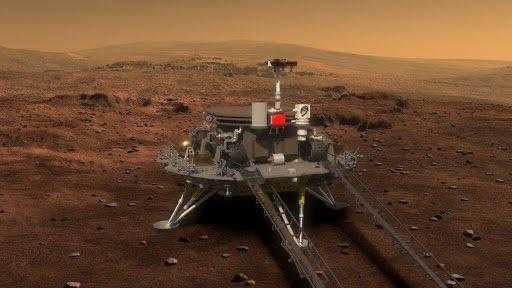China reportedly successfully landed a space probe on Mars for the first time in part of the Tianwen-1 Mission, the country’s first interplanetary attempt, Saturday. A milestone that is technically more difficult than a lunar landing is the latest step in the country’s ambitious goals in space.
After the lander and rover entered the Martian atmosphere, Tianwen-1 underwent a procedure similar to the “seven minute terror” that NASA’s Mars rover experienced while attempting a soft landing on Mars.
The Chinese National Space Administration (CNSA) instructed the Zhurong rover, after the Chinese god of fire, to stay at the landing site for several days for diagnostic tests before launching to explore an area of Mars known as the Utopia Planitia. The Chinese explorers will join forces with the explorers of the United States (US) who arrived on the “red planet” in February.
The first landing on Mars in China follows the launch of the main body of the permanent space station last month, and a mission that brought back rocks from the moon late last year.
“China has left its mark on Mars for the first time, an important step for our country’s space exploration,” the state news agency said, Xinhua, on one of his social media accounts.
Since 1976, the US has made nine successful landings on Mars. The Soviet Union landed on the planet in 1971, but the mission failed after the plane stopped sending information shortly after the landing.
A rover and a small helicopter from a US lander in February are currently exploring Mars. The US National Aeronautics and Space Administration (NASA) expects their explorers to collect their first samples in July to return to Earth in a decade.
China had landed the previous month, but landing on Mars is a much more difficult mission. The spacecraft uses shields for protection from the searing heat when it enters the Martian atmosphere, as well as retro rockets and parachutes to slow down the landing speed. The parachute and rocket had to be deployed at the right time to land at the designated place. Meanwhile, to land on the moon, you only need a mini-retro rocket, and a parachute to return to Earth.
Also Read:
NASA Delays Flight of Robot Helicopter on Mars
–
–
Xinhua said the capsule entered the Martian atmosphere at an altitude of 125 kilometers (80 miles), initiating what it called the “most risky phase of the entire mission.”
A 200-square-meter (2,150-square-foot) parachute was deployed and then dumped, then retro rockets were fired to slow the plane’s speed to nearly zero, said Xinhua. The aircraft hovered about 100 meters (330 feet) above the surface to identify obstacles before landing on four supporting legs.
“Each step has only one chance, and the actions are closely linked. If there is a shortage, the landing will fail,” said Geng Yan, an official at China’s National Space Administration.
The landing took place at 7:18 a.m., Beijing time. The distance between Earth and Mars caused a delay of more than an hour for mission control in Beijing to ensure its success.
“An important step in our country’s interplanetary exploration journey, realizing the leap from Earth-Moon to the planetary system and leaving the Chinese nation’s mark on Mars for the first time. Mother Earth and people will always remember your extraordinary accomplishments!” Said President Xi Jinping, in a congratulatory letter to the team.
“Together with the global science community, I look forward to the important contribution this mission will make to mankind’s understanding of the Red Planet,” NASA Associate Administrator Thomas Zurbuchen said on Twitter.
90 days
The Chinese landing on Mars is a top trending topic on Weibo, the leading social media platform, with a flood of expressions of joy and pride from netizens.
The spacecraft Tianwen-1, which means “Heavenly Question”, has been orbiting Mars since February, having traveled after being launched on a Long March 5 rocket in July 2020 from Earth. Xinhua described the mission as China’s first planetary exploration.
Zhurong, is expected to operate for 90 days to seek evidence of life. This tiny car-sized device has a ground penetrating radar, laser and sensors to measure the atmosphere and magnetic spheres. Zhurong will work together with orbiter Tianwen-1 to study the Red Planet, and the orbiter will serve as a data relay station for communications between Zhurong and mission controllers on Earth. The orbiter is designed to last for at least one Martian year, or about 687 Earth days.
China’s space program has proceeded in a more cautious manner than the US and Soviet Union during the height of their space race.
Also Read:
NASA Releases Panorama Images of Mars
–
–
The launch of the main module for the Chinese space station in April is the first of 11 missions planned to build and supply the station and dispatch a crew of three by the end of next year.
When the module was successfully launched, the rocket’s uncontrolled return to Earth drew international criticism including from NASA administrator Bill Nelson.
Tianwen-1 may be China’s first Mars landing mission, but it will not be its first Mars mission. The first, an orbiter named Yinghuo-1, was launched in 2011 on a failed Russian Mars Phobos-Grunt sample return mission, which never made it past Earth’s orbit after launch, instead crashing into the Pacific Ocean and destroying the spacecraft.
China is now the second country to successfully land a Mars rover (NASA has landed five explorers on Mars). The successful orbital insertion of the Tianwen-1 mission in February made China the sixth entity to do so, after NASA, the USSR, the European Space Agency (ESA), India and the United Arab Emirates.
China says it wants to land people on the moon and will probably build a research center there. No deadlines have been released for this project. A spacecraft of the country is also reportedly under development. SB / apnews / space /
(SB / mss)
Editor : M. Selamet Susanto
– .


